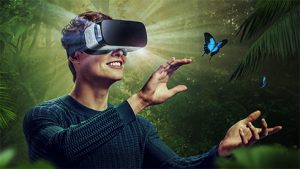To achieve the best results possible for the brands that we serve, and as part of our quest to embrace emerging marketing and communication movements, we need to take a closer look at some social trends.
Looking forward, the thing that strikes us in particular is a general sense of “harmonious contradiction”. There are two intriguing, big and bold contradictions going on which brands should try to understand and appropriate.
Tactile vs virtual & artificial
At the beginning of December, for the first time in history, the amount of money spent on vinyl records in the UK overtook the amount spent on digital downloads.
“We have a new generation buying vinyl, lots of teenagers and lots of people under 25, who now want to buy their favourite artists on vinyl and have something a bit more tangible, a bit more collectible. People have become keen to support their favourite artists by buying into that ownership concept. It’s very difficult to demonstrate your love of an artist if you don’t have something to hold on to,” said Kim Bayley, chief executive of the Entertainment Retailers Association recently.
In a digital world, consumer preference can indeed be influenced by sensory marketing tactics: think about the combined potential of sight, touch, sound, taste, and smell.
—
Even while anxieties are expressed about the impact of robots on the way we work, and the kinds of jobs that exist, millions of people have already adopted home robots. Take the Echo: it has already captured imaginations and hooked its owners on how easy it makes ordering a takeaway, or never running low on washing powder.
Brands needs to ensure that their technology/services can be linked in some way to this new kind of central domestic technology.
Local vs. e-tailing on the doorstep
It’s becoming increasingly clear that living a healthy life and thriving means putting as much care and thought into our relationship with food, as we do into our personal relationships. The best place to start working on a closer relationship with the food we eat is at local farmers’ markets and by buying from local food producers – and of course this is also true in fashion, furniture etc. Brands can tap into the trend towards these lifestyle choices by playing a facilitating role starting to allocate areas for community gardens, urban farms and local entrepreneurship.
—
Every day, a new “kit on your doorstep” initiative is launched, whether it be a meal in a kit, an outfit in a kit, or the myriad other options available. Thousands of cardboard boxes land on urban and rural doorsteps every month, containing all the elements needed to create a home-cooked dinner. Like frozen food or the microwave oven, meal kits may be a kitchen innovation that fundamentally changes how people cook at home. The cookbook author Mark Bittman told the New York Times: “It’s cooking. It’s not shopping and it’s not planning and in a way it’s not thinking, but it is cooking.”
While many question the ecological footprint of these services, brands can play a vital role in logistics and packaging innovation, offering smart recycling. Brands can help kitchens and their appliances to become smarter, and make cooking more intuitive and complex meals more accessible.
Generation Z
The first members of Generation Z will turn 21 in 2017, marking their transition from society’s teenagers to fully fledged consumers, and as such their influence will mark a tipping point for retailers. The way most retailers do business nowadays will be turned on its head, as this generation is made up of free thinkers, and sceptical when it comes to brands. They interact primarily on social media channels, simultaneously across several of them, and spend little to no time on brand platforms.
As more and more social channels integrate social shopping, brands should design even more specific content to entice this emerging group of consumers, who will be drawn to social selling storytelling. Instagram’s shoppable photo strategy is only a faint indicator of what is to come, and what will be easily adopted by these mobile natives.
Whereas platformless retail may still be considered a trend, conversational commerce will fully blossom in 2017. Chatbots and apps are now a retail tool that can boost business and increase customer service in a way that is satisfying for Generation Z.
The daily use of technology comprising chat, messaging or other natural language interfaces, short circuits the brand-to-consumer loop, facilitating “conversations” between people, brands or services, and making it possible to use a device – notably a smartphone – to ask questions, place orders and get advice.
Brands that are early adopters of this kind of commerce will certainly appeal to Generation Z, and are likely to see these consumers spending their first salaries with them rather than with traditional e-tailers. Tangible benefits of WhatsApp social commerce:
- Instant notification of messages being read.
- No queuing – 30-minute response time.
- No precious time wasted on explaining a fault or your specific need; a simple picture will do.
By linking to a CRM system, not only can brands facilitate direct sales, but track customer lifecycle too. We all remember SuitSupply in the Netherlands – the cool initiative and pilot case that resulted in an additional channel for commerce.
H&M’s bot suggests various outfits to users and provides the opportunity to purchase through the bot’s messaging platform. Sephora is using a bot to provide beauty tips and enable direct shopping.



